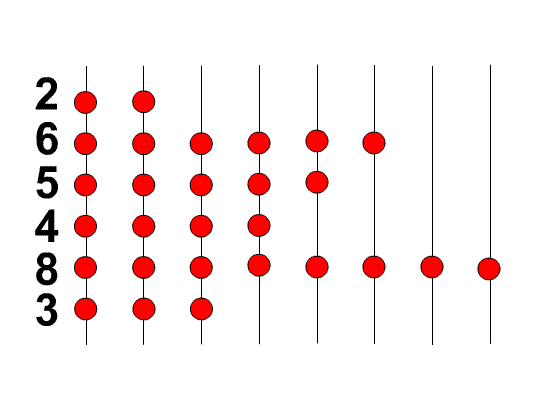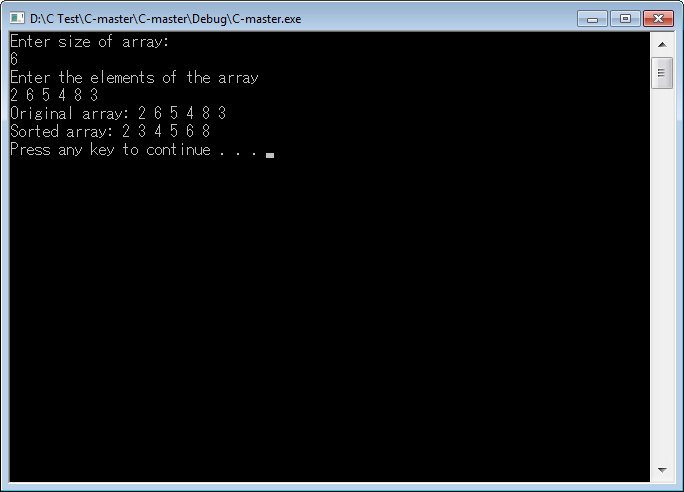排序之珠排序
先看一段动态图:

未排序前: 2 6 5 4 8 3
排序后: 2 3 4 5 6 8
步骤:
1. 每个数都分为几个1,然后在一个两维数组(待排序数组长度,数组中数的最大值)中制作珠子
2.珠子掉落
3.从上到下依次遍历,确定升序序列
代码如下:
#include <stdio.h>#include <stdlib.h>/** * @addtogroup sorting Sorting algorithms * @{ *//** Create easy access of elements from a 2D matrix stored in memory as a 1D * array */#define BEAD(i, j) beads[i * max + j]/** * Displays the array, passed to this method * @param [in] arr array to display * @param [in] n number of elements in the array */void display(const int *arr, int n){ int i = 0; for (; i < n; i++) { printf("%d ", arr[i]); } printf("\n");}/** This is where the sorting of the array takes place * @param [in,out] a array to be sorted * @param [in] len Array Size */void bead_sort(int *a, size_t len){ int i, j, max, sum; unsigned char *beads; for (i = 1, max = a[0]; i < len; i++) if (a[i] > max) max = a[i]; beads = calloc(1, max * len); /* mark the beads */ for (i = 0; i < len; i++) for (j = 0; j < a[i]; j++) BEAD(i, j) = 1; for (j = 0; j < max; j++) { /* count how many beads are on each post */ for (sum = i = 0; i < len; i++) { sum += BEAD(i, j); BEAD(i, j) = 0; } /* mark bottom sum beads */ for (i = len - sum; i < len; i++) BEAD(i, j) = 1; } for (i = 0; i < len; i++) { for (j = 0; j < max && BEAD(i, j); j++) ; a[i] = j; } free(beads);}/** @} *//** Main function */int main(int argc, const char *argv[]){ int n = 0; int i = 0; int *arr = NULL; printf("Enter size of array:\n"); scanf("%d", &n); // E.g. 8 1 2 3 printf("Enter the elements of the array\n"); arr = (int *)malloc(n * sizeof(int)); for (; i < n; i++) { scanf("%d", &arr[i]); } printf("Original array: "); display(arr, n); bead_sort(arr, n); printf("Sorted array: "); display(arr, n); free(arr); system("pause"); return 0;} |
运行结果:

分类:
C




【推荐】国内首个AI IDE,深度理解中文开发场景,立即下载体验Trae
【推荐】编程新体验,更懂你的AI,立即体验豆包MarsCode编程助手
【推荐】抖音旗下AI助手豆包,你的智能百科全书,全免费不限次数
【推荐】轻量又高性能的 SSH 工具 IShell:AI 加持,快人一步
· TypeScript + Deepseek 打造卜卦网站:技术与玄学的结合
· 阿里巴巴 QwQ-32B真的超越了 DeepSeek R-1吗?
· 【译】Visual Studio 中新的强大生产力特性
· 【设计模式】告别冗长if-else语句:使用策略模式优化代码结构
· 10年+ .NET Coder 心语 ── 封装的思维:从隐藏、稳定开始理解其本质意义